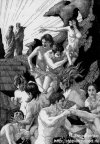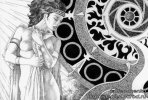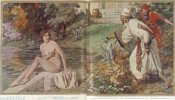-
Sign up or login, and you'll have full access to opportunities of forum.
You are using an out of date browser. It may not display this or other websites correctly.
You should upgrade or use an alternative browser.
You should upgrade or use an alternative browser.
Erotic helplessness : a study of the history of the Damsel in Distress theme in art
- Thread starter coldturkey
- Start date

catOnine
Executioner
Thank you very much for your effort, Sir.Detective mode engaged: The middle picture appears to be pro-Belgian and anti-German propaganda from The First World War. Although I have not seen this one before, there was a theme of showing invaded countries as naked crucified women, a great tradition which should be revived!
The picture is labelled "belgium-23" and there is a partly legible signature "P Cannere or Gannere" or similar. Try looking it up and see if there is more.
Edit: I tried but could not find anything else by this artist.
I´m going to offer you a reward as a private note.
mysterybadger
Executioner
anonymous00000000
Condemned
Not christians. These are supposed to be the wives of the men who accused daniel in daniel 6:24.Christians in the arena. The original file was over 10 Mo, so when I compressed it, it lost a lot of it's original quality. Any technical advice ?
mysterybadger
Executioner





Some more Fortunino Matania: Mary Read, pirate, an incident from the English Civil War, the Romans flog Boadicea, Pizarro looting, Despina Queen of the Serbs forced to serve Tamerlane naked while her caged husband looks on.
These are illustrations from the household magazine Britannia & Eve published between the wars.
malins
Stumbling Seeker
well those magazines surely knew what interests prevailed in a cultivated and fashionable householdThese are illustrations from the household magazine Britannia & Eve published between the wars.

mysterybadger
Executioner
I suppose "Does my bum look big in this?" counts as peril. This is Edwin Lonsden Long's "The Chosen Five"Excellent set.
First one remembers me one of my folders "female duelists". Could be a new thread in some weeks.
View attachment 1516064

Here the artist Zeuxis tries to recreate the beauty of Helen of Troy by inviting the five most beautiful women in Croton to model for him. Well, that was his story,
Can't wait for the female duellists thread,
catOnine
Executioner
LOVE the first one!!View attachment 1516033View attachment 1516034View attachment 1516035View attachment 1516036View attachment 1516037
Some more Fortunino Matania: Mary Read, pirate, an incident from the English Civil War, the Romans flog Boadicea, Pizarro looting, Despina Queen of the Serbs forced to serve Tamerlane naked while her caged husband looks on.
These are illustrations from the household magazine Britannia & Eve published between the wars.
coldturkey
Magistrate
Incredible Matania art ! I had never seen the Boadicea flog or Pizarro loot drawings... Nor does it appear in Google Images. Do you recall where you found it ?View attachment 1516033View attachment 1516034View attachment 1516035View attachment 1516036View attachment 1516037
Some more Fortunino Matania: Mary Read, pirate, an incident from the English Civil War, the Romans flog Boadicea, Pizarro looting, Despina Queen of the Serbs forced to serve Tamerlane naked while her caged husband looks on.
These are illustrations from the household magazine Britannia & Eve published between the wars.
coldturkey
Magistrate
coldturkey
Magistrate
malins
Stumbling Seeker
While in the days of the USSR nobody from the outside made much of a difference the artist has signed with a very typically Ukrainian name (Stepanenko), here's a few others that can be found
Attachments
mysterybadger
Executioner
The British Newspaper Archive has a pretty complete set of scans of Britannia & Eve. Matania started off illustrating a "great moments in history" series and ended up writing it himself.Incredible Matania art ! I had never seen the Boadicea flog or Pizarro loot drawings... Nor does it appear in Google Images. Do you recall where you found it ?
An interesting idea - Suspected witches were made to run over red-hot glowing plowshares to determine if magic was present. If the woman suffered wounds that did not heal immediately, then she was a witch. Only the innocent, it was presumed, would either have wounds that healed immediately, or would not suffer any harm at all. Naturally, if she didn't heal, she was burned at the stake. Most women put to this test likely had no way of escaping death. The accusation of witchcraft itself was the death sentence, it seems.
German women in the middle-ages might have benefited from a community course on firewalking.
malins
Stumbling Seeker
Surely a useful skill to learn, though of course one should remember that the vast majority of witch-hunting crazes happened in the late 16th and throughout the 17th centuries, not the middle ages. In fact during the high middle ages they were extremely rare.German women in the middle-ages might have benefited from a community course on firewalking.
It was really the availability of the printing press that allowed newly made up sensational ideas of witchcraft to spread and become contagious, starting in the later 15th century ... things like the "Malleus Maleficarum" weren't so much a summary of ancient witch-hunter experience from the preceding centuries rather than newly made up theories. Disinformation spreading in new media is not a novel problem....
Last edited:
Lev Stepanenko, active as an illustrator until about 10 years ago (so before the invasion). Most of his work online is portraits of women, but he evidently did a series of illustrations of Dante's Inferno, I think the ones you've posted are probably from that series - certainly #1, with Virgil and Dante viewing the scene.While in the days of the USSR nobody from the outside made much of a difference the artist has signed with a very typically Ukrainian name (Stepanenko), here's a few others that can be found
gerembeau
Tribune
coldturkey
Magistrate
Many thanks ! I've began perusing their database... Unfortunately they do not allow high resolution downloads, so I have to use many screenshots to try to reconstitute these treasures... Here is already Susannah and the Elders, from the August 1929 issue of B&E...The British Newspaper Archive has a pretty complete set of scans of Britannia & Eve. Matania started off illustrating a "great moments in history" series and ended up writing it himself.
Attachments
Rupert_137
Governor
In fact, hardly anyone in the late Middle Ages believed the nonsense that was compiled in Heinrich Kramer's 'Malleus Maleficarum' about witchcraft as a 'handbook for witch hunters' (first published in 1487)...Malleus Maleficarum
But some people who were obsessed with Kramer's delusions did believe... and they tortured the accused women to get the confessions they wanted. And so Kramer's absurd ideas were repeatedly confirmed by the confessions of 'convicted witches'... until more and more people fell victim to witch mania and, with a delay of almost 100 years, the great waves of witch hunts began throughout middle and northwest Europe and then raged for about another hundred years. And of course printed broadsheets like like the following played an important role.



Last edited:






















